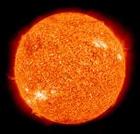 Researchers revise the solar activity forecasts
Researchers revise the solar activity forecasts
The current cycle of solar activity, marked with the number 24, was supposed to be one of the weakest. However, the Sun seems to be much more active than the first forecasts have showed - reported Dr. Arkadiusz Olech from Astronomical Centre PAS in Warsaw.
"Sunspots, the astronomer explained, are places on the surface of the
Sun, which are about 1000 degrees Celsius colder than the surrounding
matter. They are formed when magnetic activity in the area inhibits
convection and keeps colder plasma on the surface, not allowing it to
immerse and warm up again. "
The oldest method of determining the
solar activity is the number of spots described by the so-called Wolf
number. Dr. Olech explained that the calculation is very simple - the
total number of spots is added to the number of groups multiplied by
ten. "At the peak of 11-year cycle of solar activity, this number can
significantly exceed 200, and at the minimum it drops to zero" -
described the scientist.
According Olech, 2008 was an
exceptionally quiet in terms of the number of spots. 'Wolf number not
only was low, it showed a mild downward trend" - he reminded. He added
that the absolute minimum was reached at the turn of 2008 and 2009.
"According
to initial forecasts, the increase in the number of spots associated
with the Sun’s entry into a new cycle could be expected as early as
2009. But it turned out that our daily star showed one of deeper minima
in history. The year 2009 was thus very poor in spots, and even at the
turn of 2009 and 2010 there were periods, in which there wasn’t a single
spot on the face of the Sun for about a month" - said the astronomer.
Since
the second quarter of 2010 spots have begun to appear more frequently
and the activity of our daily star has clearly begun to rise. Maximum
daily Wolf number in the last year even reached 30.
"The last
maximum of 11-year cycle was very wide and occurred in the years
2000-2001, so the next should be expect in the years 2011-2012 - said
Dr. Olech. - The previous maximum was not high. The average monthly Wolf
number reached a maximum level of 170. In 1990 it reached 200, and
during a mighty peak at the end of the 1950s it exceeded 250."
The
astronomer pointed out that even at the turn of 2010 and 2011,
scientists from NASA's Marshall Space Flight Center predicted that the
upcoming maximum of cycle 24 would be one of the lowest. "The maximum
monthly average Wolf number, which we would observe in late 2012 and
2013, were to be at a level as low as 70. Last similarly low peaks were
observed in the period between 1880 and 1930, in cycles 12-16" - he
said.
Meanwhile, less than half a year after the publication of
these forecasts, it appears that the Sun surprised the scientists.
"Recently, the average monthly Wolf number has already exceeded the
level of 50, and daily could clearly exceed the level of 100. According
to revised forecasts, at the turn of 2011 and 2012, the average monthly
Wolf number can reach 100, and the current maximum may not be weaker
than the previous one" - reported Dr. Olech. (PAP)
last modification: 2011-05-16













































 Researchers revise the solar activity forecasts
Researchers revise the solar activity forecasts